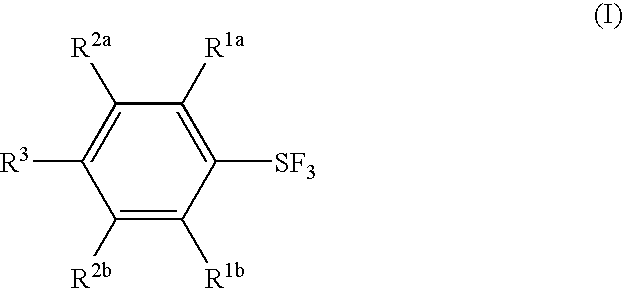Substituted phenylsulfur trifluoride and other like fluorinating agents
a technology of phenylsulfur trifluoride and substituted phenylsulfur, which is applied in the field of fluorinating agents, can solve the problems of cost and scarcity of natural fluorine-containing compounds, and achieve the effect of substantial functional and safety benefits
- Summary
- Abstract
- Description
- Claims
- Application Information
AI Technical Summary
Benefits of technology
Problems solved by technology
Method used
Image
Examples
example 1
Preparation of bis(2,6-dimethyl-4-tert-butylphenyl)disulfide
[0044]The following reaction scheme is provided as illustrative:
[0045]
[0046]A two liter, three-neck flask, was obtained. A condenser with a drying tube, a thermometer, and a dropping funnel were each attached to the flask. Zinc dust (1H NMR (CDCl3) δ 7.04 (s, 4H), 2.23 (s, 12H), 1.30 (s, 18H).
[0047]The present example illustrates the utility of the present invention for synthesizing fluorinating agents that can be used to produce fluorine-containing compounds.
example 2
Synthesis Embodiment of 2,6-dimethyl-4-tert-butylphenylsulfur trifluoride, A Fluorinating Agent of the Present Invention
[0048]The following reaction scheme is provided as illustrative for this example:
[0049]
[0050]A 100 ml fluoropolymer-round flask equipped with a magnetic stirrer, a thermometer and a solid addition funnel connected to a drying tube, was flushed with dry nitrogen and charged with 16.08 grams (g) (111 mmol) of silver difluoride and 20 ml of anhydrous 1,1,2-trichlorotrifluoroethane. Bis(2,6-dimethyl-4-tert-butylphenyl)disulfide (6.03 g, 16.3 mmol), charged in the solid addition funnel, was added to the stirred slurry in small portions to maintain the temperature of reaction mixture between 35 and 40° C. The addition of disulfide required approximately twenty minutes.
[0051]The reaction mixture was stirred for an additional thirty minutes at room temperature, and then heated to reflux for about five minutes. The reaction mixture was filtered under a blanket of dry nitrog...
example 3
Synthesis Embodiment of 2,6-dimethyl-4-tert-butylphenylsulfur trifluoride, A Fluorinating Agent of the Present Invention
[0054]The following reaction scheme is provided as illustrative for this example:
[0055]
[0056]Chlorine (Cl2) was passed at 23 ml / min through a stirred mixture of 5.79 g (15.0 mmol) of bis(2,6-dimethyl-4-tert-butylphenyl)disulfide and 8.7 g (58.1 mmol) of spray-dried potassium fluoride (KF) in 30 ml of dry acetonitrile cooled on an ice bath. After 1.18 L (52.5 mmol) of chlorine was passed, nitrogen was passed through at the rate of 25 ml / min for two hours. The reaction mixture was filtered in a dry atmosphere. The filtrate was evaporated under vacuum (10-20 mmHg) at 20° C. and the residue distilled at reduced pressure to give 2,6-dimethyl-4-tert-butylphenylsulfur trifluoride (see Formula IV, Table 3) (bp 68-70° C. / 0.1 mmHg (4.1 g, 55% yield, purity of >97.4%)). Spectral data was the same as shown in Example 2.
[0057]The present example illustrates the utility of the p...
PUM
| Property | Measurement | Unit |
|---|---|---|
| Temperature | aaaaa | aaaaa |
| Temperature | aaaaa | aaaaa |
| Temperature | aaaaa | aaaaa |
Abstract
Description
Claims
Application Information
 Login to View More
Login to View More - R&D
- Intellectual Property
- Life Sciences
- Materials
- Tech Scout
- Unparalleled Data Quality
- Higher Quality Content
- 60% Fewer Hallucinations
Browse by: Latest US Patents, China's latest patents, Technical Efficacy Thesaurus, Application Domain, Technology Topic, Popular Technical Reports.
© 2025 PatSnap. All rights reserved.Legal|Privacy policy|Modern Slavery Act Transparency Statement|Sitemap|About US| Contact US: help@patsnap.com



